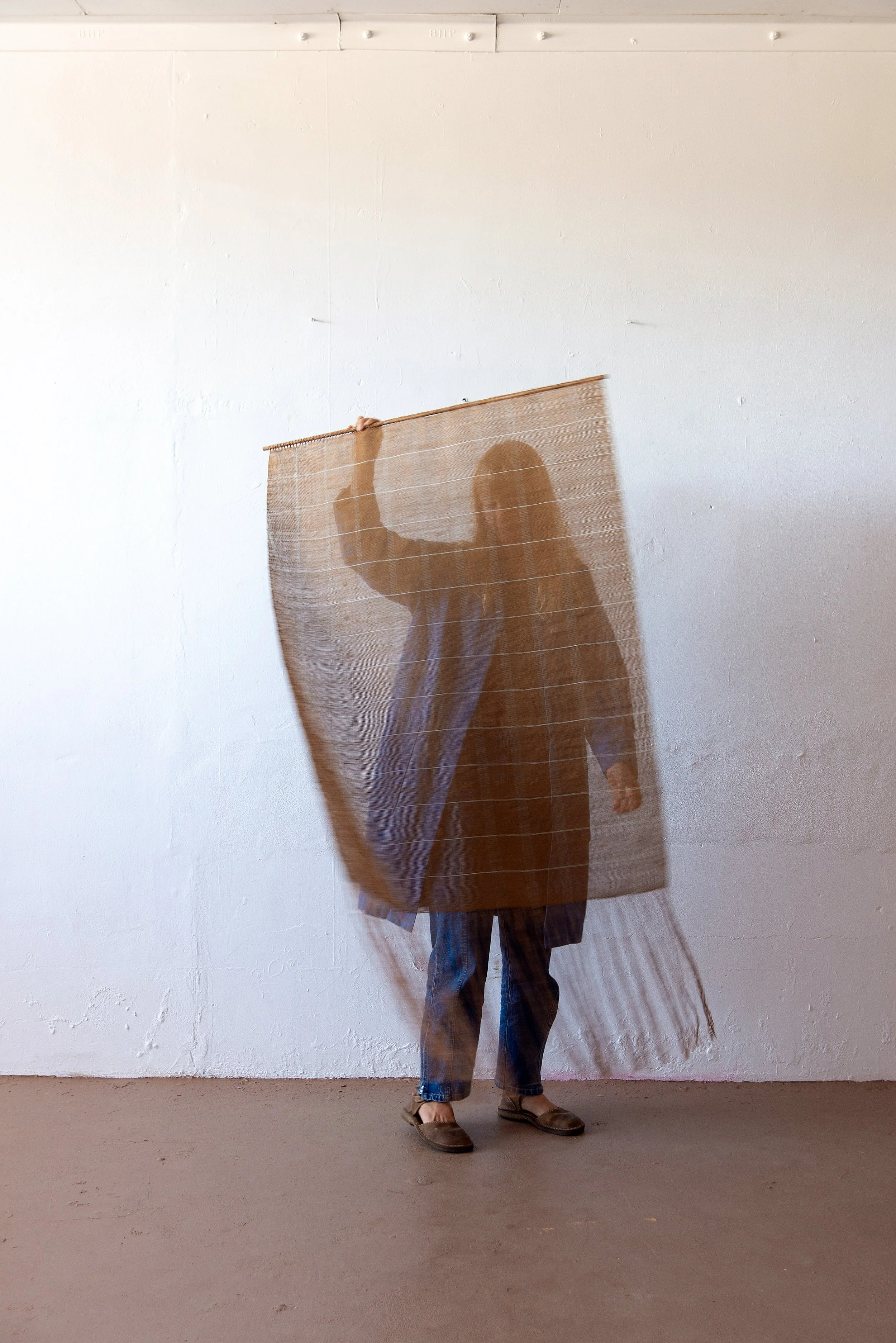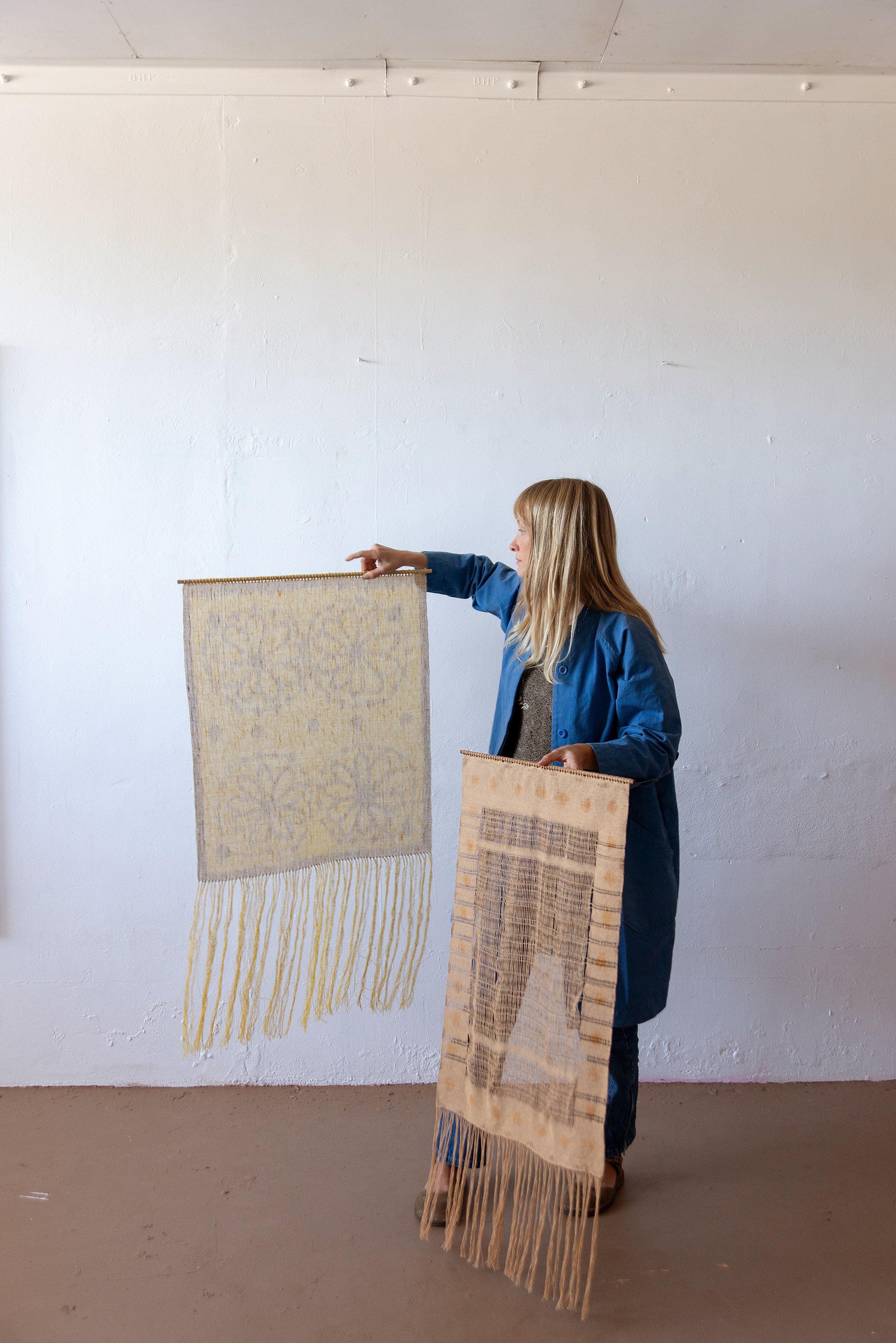Tais Rose Wae
Name: Tais Rose Wae
Pronouns: She / Her
Studio location: Bundjalung Country, on the east coast of Australia
Website / social links: taisrosewae.com , @tais_rose
Loom type or tool preference: rigid heddle loom
Years weaving: 5
Fiber inclination: silk, linen, inclusion of pearls, intricate hand-forged gold beads, snake bones, scribbly-gum tree bark, shells, seaweed.
Current favorite weaving book: I love ‘Tayenebe: Tasmanian Aboriginal Women’s Fibre Work.’ I am also always returning to books on Anni Albers and Lenore Tawney.
Contact information for commissions and collaborations: email address
1. How did you discover weaving and was what your greatest resource as a beginner?
My weaving practice began with basket making seven years ago and transferred to the loom five years ago. It started as a medium through which to navigate a difficult time in my life and has grown into my primary art form. I am self-taught and have mostly made things up as I go and like to keep things simple, with my emphasis usually falling more on the desire to tell a story than to work with very technical weaving styles. I refer to a lot of art and resources that aren’t usually associated with weaving, but also spend a lot of time reading about and looking at work from classic weavers.
2. How do you define your practice – do you consider yourself an artist / craftsperson / weaver / designer / general creative or a combination of those? Is this definition important to you?
I am a multidisciplinary artist, weaver and poet. I have just had my first poetry collection, ‘Riverbed Sky Songs,’ published at the end of 2023, and I think all my art mediums and processes are inevitably intertwined. There is an undeniable quality that has formed in my work and life and I can see how that shows up as a somewhat consistent aesthetic, but it’s not fixed. I am drawn to natural colours and materials, to ways of using light, to the ethereal shine of pearls, but I’m also open to that changing and to my work taking on an entirely new direction. I think of my practice as being quite watery and river-like, it expands and grows with me as a way to express that change. There is no real destination and I leave a lot of room for experimentation and reflection. There is also this sweet spot that exists between rest and creation, and the more I slow down into the ebbs and learn from what arises in the stillness, the more I am able to return to myself and create from a space of integrity. It is often when I return to the rockpools or river with my son and properly distance myself from my work that inspiration returns.
3. Describe your first experience with weaving.
With my first ever loom weaving, I made a very simple chequered work with oranges,reds, yellows and browns. I was instantly captivated and enamoured by the process and possibility. It is a slow progression, from the first warp thread to pass through the heddle to the last knot tied on each piece and I don’t have much time to weave in this current season of my life, but it is always a generous and healing process for me to return to. The inward quietness of it all has been a gift.
4. What is your creative process, from the initial idea to the finished piece? Are there specific weave structures, looms, or fibers that are important to your process?
Most of the time I have a vision of the weaving finished in its entirety during the warping process. I’ll have a myth or poem or cyclical process in my mind and am able to see and feel how it needs to conceptually come together in those early stages. At the moment I am working with linen yarn and find myself painting spirals onto the warp threads and later sewing pearls, shells and hand-forged gold beads into the tapestry that I have been dreaming of making for a couple of years now.
5. Does your work have a conceptual purpose or greater meaning? If so, do you center your making around these concepts?
Weaving feels like a visual expression of what I explore through my poetry. The messages and meanings follow a similar thread but exist through different materiality. I also explore my Aboriginal ancestry within my work, and that takes on its own visual language and historical meaning. The same strips of bark or river pearls or sea urchinspikes or silk or snake bones that appear in my weavings are often the backbone of my poetry. But the weaving also has this element that is abstracted in hidden ways. A story will be laid out and measured and intertwined into the structure of the weaving and there is also something about the immense amount of time it takes to make a weaving that has a great deal to do with the story that is embedded. The act of weaving, with its repetitive knots and countless hours at the loom, provides fertile ground for reflection and contemplation, allowing me to bring forth stories and memories into the narrative of each weaving.
6. What is your favorite part of the weaving process and why? What’s your least favorite?
My favourite part about the weaving process at the moment is when the weft yarn begins to cross through the painted warp threads for the first time. To watch the painting come to life in that solidified way always feels exciting. There’s also something so thrilling about cutting a new weaving free from the loom. My least favourite part is probably the tying and untying of so many knots, or when the shuttle catches on a warp thread and sometimes destroys the weaving by jumbling the painting on the threads.
7. Do you sell your work or make a living from weaving? If so, what does that look like and how has that affected your studio practice?
My husband and I are both artists. Heath is an incredible painter who exhibits his work internationally, and between the two of us, we have made an income and supported our family solely through art for the last four years or so. We get to spend our days with our son and can be flexible around our studio hours, and we feel incredibly blessed in that way.
8. Where do you find inspiration?
I think that the themes I explore in my work tend to follow me, or perhaps it is more true that I follow them. There is a curiosity that shows up equally in conversation, in the books I read and the films I watch and the places we visit. The weaving and the poetry are one and the same, but I also enjoy leaning into other ways of making art. At the moment I’m really drawn to making cyanotype prints, but I’m also always thinking about the process of painting.
We bring art into all areas of our family life. The richest inspiration I have found is in the watery paintings that my son makes. He often wakes up before the sun and asks me if he can go outside to paint. I witness how immensely freeing and joyful it is forhim and am obviously deeply inspired by that, but there’s something about the beautiful unabashed use of colour, the innocence and simplicity of not just the paintings but his process… there’s a subtle energy to it all that I seek to bring into my art. I use the remnants of his jars of paint on the warp threads of my weavings and he often asks if he can help.
9. What other creatives do you admire – weavers, artists, entrepreneurs – and why?
I am very inspired by many of the people in my life – family, friends, neighbours, local artists, mothers, elders, mentors – and then also by great thinkers and writers and artists, like Mabel Juli, Tara June Winch, Bruce Pascoe, Lenore Tawney, Hilma af Klint, Deborah Levy, Oodgeroo Noonuccal, Anni Albers, Ali Cobby Eckermann, Rachel Carson, Tyson Yunkaporta, Alison Whittaker, the list goes on.
10. If you could no longer weave, what would you do instead?
I have been making short films inspired by poetry since I was in high school and have been weaving this metaphorical tapestry of the liminal possibilities that exist between weaving and poetry and art at large. I was commissioned to create different versions of visual storytelling and poetry in the form of audio artworks and films for The Biennale of Sydney, Powerhouse Museum in collaboration with Temporary Position, and a regional gallery recently. This new way of creating really brought a lot of momentum and fresh energy into all area of my practice and I enjoy leaning into and re-shaping the previously felt boundaries of my practices by finding new ways of telling a story.
Do you have any upcoming exhibits, talks, or events the community should know about?
I have got an upcoming solo show with The Dot Project in the UK in April 2024. It will be a story laid out in linens, hand-spun silks, river pearls, intricate shells, seaweed, dried native grasses and hand-forged gold ‘pearl-like’ beads sewn into the weavings…lots of spirals and serpent energy.
images by Lisa Sorgini and Natalie McComas














